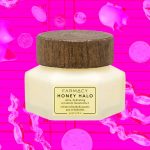“Early prototypes of the Flyaway Attachment featured brush-style bristles, directly mimicking a stylist’s brush and blow-dryer technique,” Veronica Alanis, engineering lead at Dyson, tells Refinery29. “However, without the skill and steerage of a stylist adopting the original technique, the bristles were found to hinder more than help.” By utilizing the power of airflow, the team settled on an “optimum curve” design for the Flyaway attachment to guide the airflow to effectively harness the Coanda effect. (In short, it’s the same technology that the Dyson Airwrap styler uses to “attract and lift longer hairs to the front, whilst pushing flyaways through the tresses and out of sight,” explains Alanis. By essentially hiding flyaways, the attachment leaves hair looking shinier and straighter. “The new Flyaway Smoother is engineered to provide fast, smooth styles from wet to dry, all in one attachment,” explains John McGarva, head of hair care design engineering at Dyson, via press release. “Taking advantage of the Coanda effect, the attachment is also able to tuck in and hide flyaways, replicating the techniques used by professionals in salons.”
Dyson Flyaway Attachment Supersonic Hair Dryer Review



